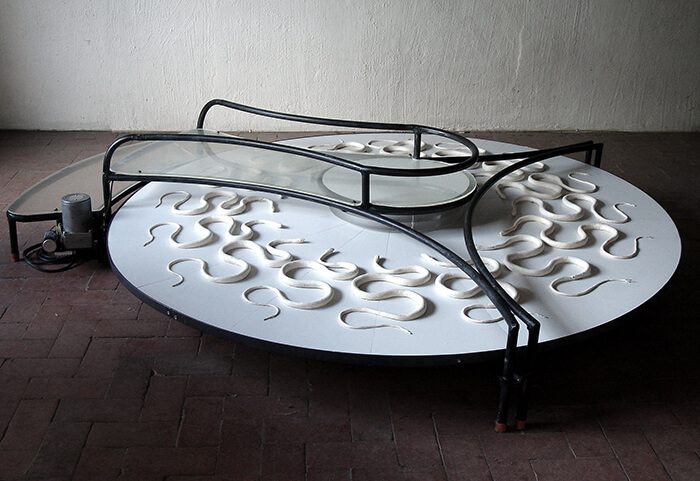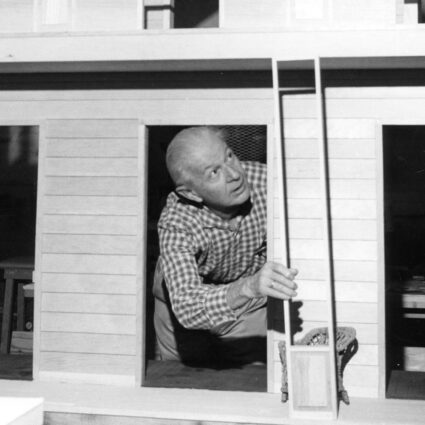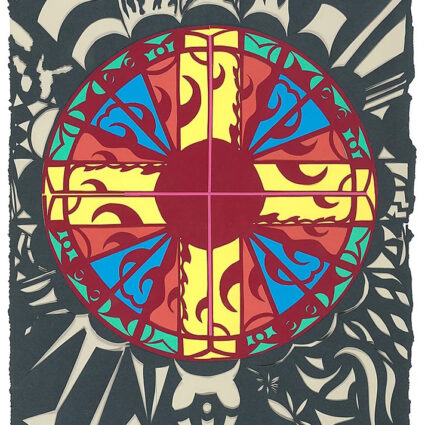
Sanitary Tortilla Factory, Albuquerque
August 18 – September 16, 2017
The thick metal door swung shut behind me, and the momentum of its thud closed off the thrum of traffic from Coal Avenue, quieting the world inside the gallery. In the small exhibition space of Sanitary Tortilla Factory, machinery began to whirr, set off by the movement of my body in the empty room. This is part of the revelation of Wave, a collection of two-dimensional work and mixed-media sculpture by Steve Barry: the viewer is immediately inserted into the work. In order to engage with Wave, it is necessary to be present in your particular body, in that particular space. Here, visitors chase something ancient by gazing into the metal, motion, and geometry of the work.
Of the nine pieces included in Wave, five emphasize the curving lines of snakes, but Barry doesn’t see them as creeping, crawling emblems of preternatural fear. Instead, as he writes in his artist statement: “The Ourobus [sic] is an ancient symbol of eternal renewal … The cycle (Homeric and otherwise) is an old saw made evident by a profusion of circles in my machines. Attempting to end the constant repetitions of Euclid, while allowing a continuous path forward, I turn to the snake for guidance.” The ouroboros is read as movement with return. Laocoon, the centerpiece of Wave, spun as I approached it. Laocoon—which is also the name of a mythic Trojan priest killed by sea snakes depicted in a famous ancient sculpture—is now mechanized and hums awake when movement is present. The flat white disc, about four feet in diameter, came up to my mid-calf and spun until what twisted across its flat top became obscured. As I stood still, it buzzed and slowed to a halt, its white sculptural snakes in uniform slither, evenly spaced across the machinery.
Like film giving motion to static imagery, the movement of Laocoon is integral to the questions raised in this body of work—to sensing both movement and stillness within the never-slowing march of time. Pairing the ancient symbolism attached to the snakes and the geometry of the circular substrate with a modern machine to give them life emphasizes the vastness of the planet’s timeline. Again, in Barry’s artist statement: “Minor artists like myself never fully escape the orbit of History. Maybe it is love, or for lack of trying,” he mused. The ceaselessness of time, the always-advancing moment, becomes a wave eternally returning to shore, connecting the endless circle from ancient through modern. All tidily summed up in the title, Wave.

Like a venom, the work knocks you into the artscape of the gallery. This is most evident in the sculptural Aesculapius. A paneled mirror faces the viewer with two half circles on either end of long rectangular panes. In a cylinder nested in the center, something is visible within, yet obscured by smoked glass. You lean in closer and closer to see what’s there, triggering the motion of yet another snake, this one circling endlessly upward. Entranced by the movement, you are simultaneously bending closer to yourself, soon jolted into awareness that you are gazing into your own eyes.
Works like Aesculapius are an antidote to a tendency to remove ourselves from the site-specific engagement with art, acting as modern intellect instead of an individual body poised at a unique point in history with a particular perspective. Our lives are each on a timeline that necessarily exists within a universe of natural cycles. Barry’s Wave helps us recognize ourselves as part of that broad landscape. It is perhaps good that most artists “never fully escape the orbit of History,” and that by this very quality their work becomes resonant, much like the work in Wave.



